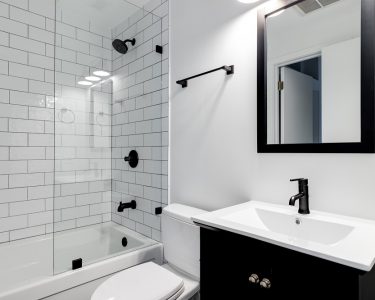When it comes to bathroom design, many homeowners face a huge dilemma: bathroom tiles versus bathroom painting. It’s no secret that bathroom aesthetics and functionality are incredibly important to the space and overall home. This importance leads to the very common dilemma homeowners often face when choosing between tiling or painting their bathroom walls. This article will explore several points of comparison between bathroom tiles and bathroom painting, with a focus on cost, durability, maintenance, and aesthetic appeal.
Cost Comparison
Initial Cost
Let’s begin with a comparison of cost when considering bathroom tiling vs. painting. Painting is typically more budget friendly, with costs usually ranging from $1 to $3 per square foot of paint. On the other hand , bathroom tiles tend to have higher upfront costs due to the need for more raw materials and professional installation by well-trained contractors. That being said, some contractors may offer discounts for bulk purchases. Therefore, some careful planning can alleviate some of the initial costs of bathroom tiles and bathroom painting.
Long-term Cost
Bathroom tiling vs. painting long term costs are a different story. Bathroom painting will require periodic repainting every few years, which drives long term costs up. Meanwhile, bathroom tiling boasts a higher initial investment as mentioned above, but has a less frequent need for replacement or repairs. This leads to significant cost savings in the long term.
Durability and Maintenance
Durability
Now it’s time to compare the durability of bathroom tiles and bathroom painting. Bathroom tiles are made from especially durable materials such as ceramic, porcelain, or glass. This makes them resistant to moisture, stains, and changes in temperature. Alternatively, bathroom painting can be susceptible to peeling and chipping in high moisture and humidity environments like bathrooms. However, there are special bathroom paints with mildew-resistant properties. These paints can offset the harmful effects of moisture and mildew, but are not as durable as bathroom tiles.
Maintenance
When it comes to maintenance, it’s easy to compare bathroom tiling vs. painting. Bathroom tiles are significantly easier to clean with regular, periodic wiping. That being said, the grout between the tiles also needs some maintenance to prevent harmful growths like mold and mildew. Bathroom painting, however, needs more gentle cleaners to avoid damaging the paint surface, as well as more cleaning and potential repainting.
Aesthetic Appeal
Variety and Customization
In terms of the variety and customization properties of bathroom tiling vs. painting, they can differ greatly. Bathroom tiles come in a huge variety of colors, patterns and textures, which you can leverage to create a luxurious, cohesive look for your bathroom. Bathroom painting, meanwhile, offers significant flexibility in color choices and design. The more frequent need for repainting also provides a blessing in disguise: you have more opportunities for easy updates and personalization via different paint techniques and finishes.
Style and Trends
There are also different styles and trends to consider when determining if bathroom tiles or bathroom painting is better for your needs. Bathroom tiles boast a long lasting appeal, making them suitable for both classic and contemporary designs. Whichever design you choose can also be complemented with accessories for a refreshed look. On the other hand, bathroom painting can be easily adaptable to changing trends. More frequent paint updates can also keep your bathroom looking fresh and modern.
Waterproofing and Mold Resistance
Waterproofing
Waterproofing and mold resistance are incredibly important considerations when determining bathroom tiling vs. painting, for both the look of your bathroom as well as your health. Bathroom tiles are naturally water resistant and typically used in high moisture areas. As long as they’re installed properly by a reputable contractor, excellent waterproofing is ensured. Bathroom painting, however, is less effective at preventing mildew in very wet environments, despite the existence of water and mildew resistant paints.
Mold Resistance
Mold resistance is not something you want to mess with, since it can impact your health and that of your family or any guests. Bathroom tiles are easier to clean, therefore easier to keep mold free, but the grout lines, as mentioned above, need regular attention to prevent mold. Bathroom painting does include mildew resistant properties like mentioned above, but your walls will still require regular cleaning and mold inspections to prevent the propagation of mold and mildew.
Hybrid Approach
Combining Tiles and Paint
One way to solve the bathroom tiling vs. painting dilemma you may be facing is to combine bathroom tiles with bathroom painting. For example, you can use tiles in high-moisture areas such as around the shower and sink. In the other areas, you can use paint. This way, you strike a balance between cost and functionality. Combining tiles and paint provides a cost-effective, customizable, and practical solution for many bathrooms.
Key Comparisons Between Bathroom Tiling vs. Painting
When comparing bathroom tiles and bathroom painting, it’s important to look at things from several standpoints. These important standpoints include cost, durability and maintenance, as well as aesthetic appeal. Of course, you should also consider your own individual needs, budget, and maintenance preferences. This way, you can use the information presented in this article to align your decisions with your personal needs. For example, if you need durability and easy maintenance, you should go with bathroom tiles. Alternatively, if you need budget friendliness and frequent updates, choose bathroom painting.




